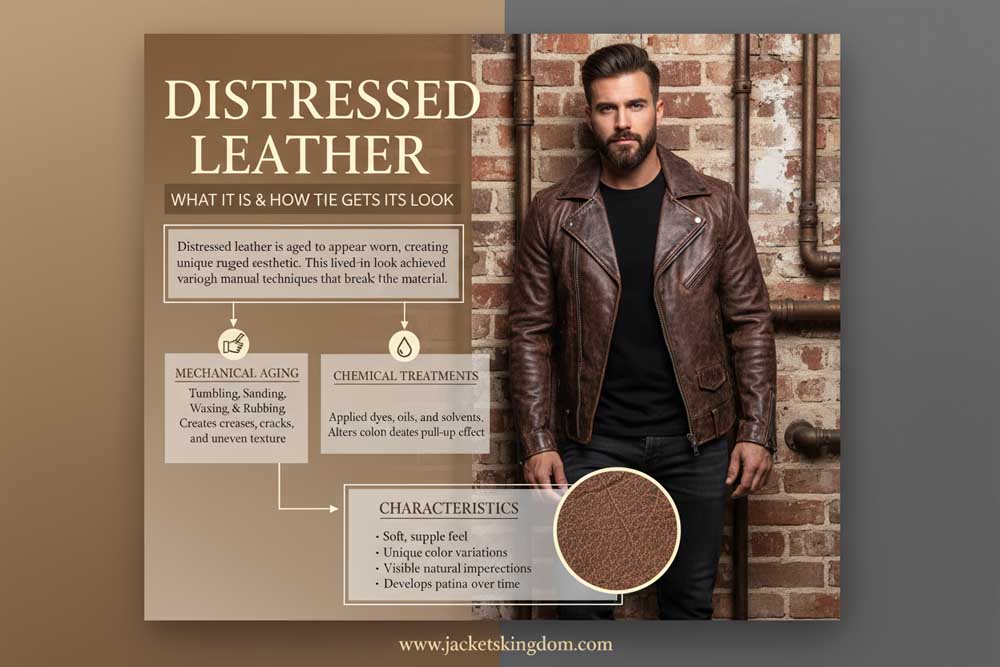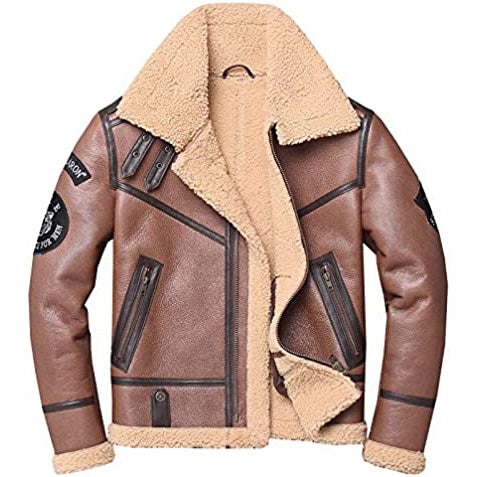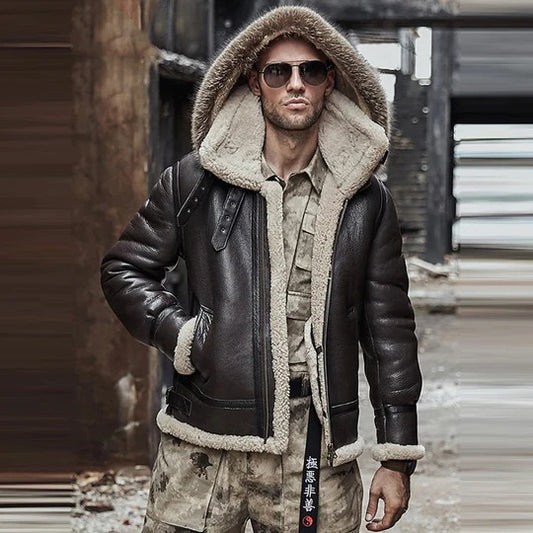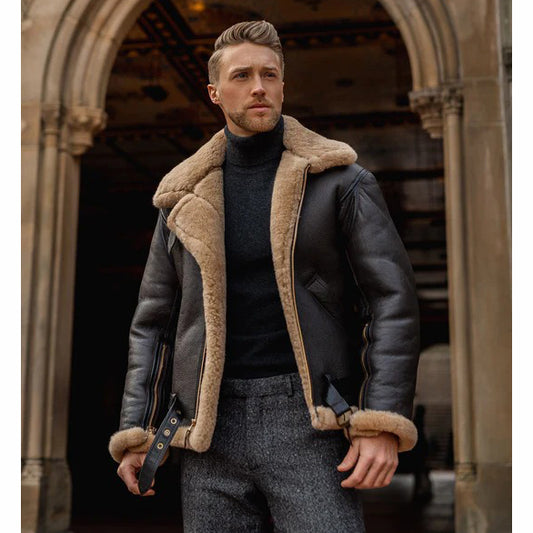Key Takeaways
-
Distressed leather is genuine leather that’s been intentionally treated to look worn and aged.
-
The look is achieved by mechanical, chemical, or manual processes and often uses high-quality raw hides.
-
When done right, distressed leather offers both style and durability—but you must know how to evaluate and care for it.
-
For jackets and accessories, understanding the difference between distressed leather and other leather finishes helps you make better buying decisions.
Introduction
Imagine pulling on a leather jacket that already feels like it’s lived a little—a soft patina, varied tones of color, gentle wear in the right places. That’s the appeal of distressed leather. On one hand it has that worn-in character; on the other, it still gives you the structure and durability of genuine leather. At Jackets Kingdom we believe this finish gives jackets and accessories a unique personality. In this article we’ll walk you through exactly what distressed leather is, how it gets that look, why it’s so popular, and how you can recognize and care for it. By the end you’ll feel confident spotting and buying great distressed leather pieces.
What Is Distressed Leather?
Distressed leather is a term used for leather that has been treated to have an aged, worn, or weathered appearance—even if it’s brand new. According to several sources, it’s “normal leather that has been purposefully aged, worn and ruggedly treated to seem” worn-in. Unlike glossy, smooth leather finishes, distressed leather celebrates variations: color shifts, minor scratches, soft creasing, and a patina-like texture. In essence, it’s genuine leather (often full-grain or top-grain) which has undergone extra finishing treatment so it looks like it’s been around a while.
In practice, when you see a jacket labelled as “distressed leather” at Jackets Kingdom, what you’re getting is a piece that looks lived-in from day one—but still has the strength and durability of premium leather. The look is intentional, and that gives the item personality.
Why Choose Distressed Leather? The Appeal and Benefits
When you’re shopping leather jackets or accessories for your site, the distressed leather finish offers several advantages:
-
Visual character: The worn-in look gives each piece a unique vibe. No two items will show identical wear patterns or color shifts. That rustic, vintage feel draws attention.
-
Softness and comfort: Many distressed leather items are already broken-in to some degree, so they feel comfortable from early wear. Sources say that the processes used can make the leather softer and more supple.
-
Works with everyday use: Because the wear is already built in, further use doesn’t necessarily harm the appearance—it may even enhance it. Some makers call this an advantage: the look “improves” with time.
-
Stylized authenticity: For fashion brands like ours, offering jackets with a distressed finish taps into the desire for authenticity and character—not just new-and-perfect.
-
Differentiation: In a sea of smooth glossy leather jackets, a distressed finish helps your product stand out.
That said, there are trade-offs (we’ll cover in the “cons” section) and you should pick carefully.
The History and Evolution of Distressed Leather
It’s useful to know how the distressed finish came to be and why manufacturers apply it. Historically, leather developed its character through use—scratching, exposure, handling would naturally change its surface over years. But as fashion demands changed, the need arose for that vintage aesthetic without waiting decades.
In earlier times, distressing was done by hand: sanding, burning, waxing the hide during manufacturing. With modern technology, tanneries now use mechanical, chemical, even robotic methods to accelerate the effect.
For example, one blog pointed out: “Since leather has been around for ages … wear and time were the only ways to get the distressed look. … In the 2000s producers added lasers, which significantly sped up the creation of this worn leather.”
So when you see a distressed leather jacket at Jackets Kingdom, you’re looking at the culmination of this evolution: traditional craftsmanship plus modern finishing techniques.
How the Distressed Look Is Created
Creating the distressed finish for leather is both an art and a technical process. Here are the main techniques used in the industry to achieve that worn-in look:
Mechanical Treatment
This involves physically altering the leather surface. Examples include:
-
Sand-or buffing the surface to remove or soften the top layer.
-
Creasing or crumpling the hide to emphasize grain lines or wrinkles.
-
Rolling, stamping or pressing to create indentations or surface variations.
Chemical or Dye Treatments
These change color, tone, and finish. Techniques include:
-
Over-dyeing the leather so that different areas have lighter or darker tones, giving depth.
-
Applying waxes or oils that emphasize creases and age marks. (For instance: “wax, seed oils, naturally occurring lipids” in some leather care references)
-
Using solvents, alcohol or other agents to degrade the finish in a controlled way.
Finishing and Patina Enhancement
Once the mechanical and chemical processes are done, finishing touches add character:
-
Top-coats may be removed or minimally applied so the grain shows through.
-
Ageing marks are emphasised.
-
The hide is sealed in a way that still highlights surface “imperfections” as part of the aesthetic.
At Jackets Kingdom, when we describe a jacket as distressed leather, we rely on these sorts of finishes to give it that rugged, lived-in look—but still ensuring the leather quality (hide quality, tanning method) is high grade so it performs well.
Distressed Leather vs Other Leather Finishes
To make informed choices for your store or for your customers, it’s key to understand how distressed leather compares with other types of leather finishes.
Distressed vs Regular Smooth Leather
-
Regular leather typically has a uniform finish: smooth, glossy or semi-matte, without intentional wear marks or colour variation.
-
Distressed leather embraces variation: scratches, color shifts, texture irregularities.
Distressed vs Vintage Leather
-
Vintage leather is genuine leather that has naturally aged over many years—its patina developed through use.
-
Distressed leather is manufactured to look aged, but it hasn’t necessarily had decades of use.
Distressed vs Pull-Up or Crackled Leather
-
Pull-up leather: oils/waxes cause color changes when stretched; the finish shifts and lightens under stress.
-
Crackled leather: surface purposely finished to crack or fissure in a patterned way.
-
Distressed: broader category, focusing on worn look rather than specific crack or colour-lift effect.
Distressed vs Faux Leather
-
Faux or synthetic leather can try to mimic the distressed look, but typically lacks the depth, grain character, and aging potential of genuine leather. Many sources emphasize that distressed leather uses full-grain leather.
When you display a product at Jackets Kingdom as “distressed leather”, you can highlight: “Authentic full-grain hide, purpose-treated for a vintage worn look”.
How to Recognize Quality Distressed Leather
Since distressed leather emphasizes “imperfections”, it can be easy to pass off a low-quality hide with heavy distressing as something premium. As a copy-writer you want to equip your customers with what to look for. Here’s how to recognise genuine, high-quality distressed leather:
-
Hide source and grain: High-quality distressed leather usually starts from full-grain or top-grain hides. If it’s split or bonded leather, the distress finish may hide inferior structure.
-
Finish consistency: Although the look is “worn”, the distressing should be even and intentional—not patchy or obviously damaged.
-
Surface feel: The texture should feel supple, not plasticky or overly brittle. If the distressing looks cracked or the leather feels stiff, that could signal poor treatment.
-
Backing and stitching: Quality stitching and backing reinforce the structure—important since the surface treatment adds stress to the hide.
-
Brand transparency: Good brands (like ours at Jackets Kingdom) will list the type of leather (e.g., “distressed full-grain cowhide leather”), the finish process or its intended look, and care instructions.
-
Patina adaptability: Genuine distressed leather often develops a richer patina with use, rather than deteriorating.
Using these checkpoints in your product descriptions helps build trust: you’re promising more than an aesthetic effect—you’re offering durability and style.
Why Distressed Leather Looks Aged: The Science Behind the Look
Understanding why distressed leather looks the way it does improves how you explain it to customers and craft content for your store.
-
Grain and surface markings: Genuine hides carry natural grain, pores, small scars. In distressed leather, these are emphasized rather than hidden, giving visible texture and variation.
-
Color variation and depth: Through dyeing and layering, some areas are lighter, some darker, which mimics decades of wear.
-
Softened fiber structure: Mechanical processing loosens fibers, making the hide more flexible, giving it that broken-in feel.
-
Patina simulation: Patina is the surface change that occurs with age (color shift, matte areas, sheen in worn areas). Distressing accelerates that process.
-
Surface micro-damage: Controlled surface abrasions, buffing, or chemical treatment create micro-imperfections that catch light differently, giving a lived-in effect.
Communicating some of this science in your e-commerce copy adds credibility: you’re not just selling a look—you’re explaining the craftsmanship and process.
Where Distressed Leather Is Commonly Used
The distressed finish is popular across many leather goods. At Jackets Kingdom we focus on jackets, but the material extends beyond. Here are common applications:
-
Leather jackets and coats: The worn rugged look is especially effective in outerwear—gives character and edge from day one.
-
Bags and accessories: Messenger bags, wallets, belts, watch-straps benefit from distressed leather because wear is less of an issue when the look is built-in.
-
Footwear and boots: Distressed leather adds toughness and vintage appeal to boots, sneakers and shoes.
-
Furniture and upholstery: Sofas, chairs made of distressed leather bring an aged, comfortable look to interiors.
In your product copy for jackets, you might highlight that the jacket is made from “premium distressed leather hide, giving you that broken-in vintage look with genuine leather durability” to appeal to style and function.
Pros and Cons of Distressed Leather
When writing copy you want to give a fair, balanced view. Here are the major pros and cons.
Pros
-
Character and uniqueness: Every piece has variations, making it one-of-a-kind.
-
Softness and comfort: Often more flexible and comfortable earlier.
-
Tolerates wear well: Since the look is already “worn”, further wear can enhance it rather than spoil the aesthetic.
-
Style versatility: Works well across casual, urban, vintage, rugged looks.
-
Durability when done right: If high-quality hide and finishing used, distressed leather will last.
Cons
-
Price: Premium distressed leather tends to cost more because of the hide quality and finishing work.
-
Appearance can vary: Because of the deliberate imperfections, some buyers might perceive “defects” rather than “character” if not ready.
-
Care required: Worn surface may be more susceptible to moisture, scuffs, color transfer if not protected.
-
Less formal: The aesthetic is decidedly casual/rugged—may not suit very formal leather uses.
When you write product copy, you can emphasise the pros and set expectations about care and style—building trust with your audience.
How to Care for Distressed Leather
Good care ensures that a distressed leather piece from Jackets Kingdom remains a stellar look and lasts long. Here are care tips:
-
Avoid prolonged exposure to direct sunlight or strong heat sources (can dry out leather).
-
Use a soft cloth or microfiber to wipe dust and debris.
-
Apply a good leather conditioner or wax suitable for distressed finishes to maintain suppleness and color. As one source says: “waxing ... provides moisture … to support its true flourishing.”
-
If the product gets wet, blot the moisture and let it dry naturally (not with direct heat).
-
Store in a cool, ventilated space; avoid plastic bags that trap moisture.
-
Avoid sharp objects or overly rough surfaces that may cause deep scratches (though some wear is expected).
-
For minor scuffs or color changes, use a leather dye or wax in a matching tone—but test in a hidden spot first.
When offering jackets, you can include a short “care instructions” section to reinforce value and help the customer feel confident.
How to Choose a Distressed Leather Jacket
Here are some features to highlight and tips to help customers choose well:
-
Hide type: Check that the jacket is made from full-grain or top-grain distressed leather rather than split or bonded.
-
Weight and thickness: Heavier leather (e.g., cowhide 1.2–1.4 mm) will feel sturdy; distressed jackets still need structure.
-
Finish description: Mention how the distress effect was achieved (hand-buffed, wax-finished, over-dyed) to emphasise authenticity.
-
Color variation & tone: Show how darker and lighter zones exist; gives preview of the unique character.
-
Brand credibility: At Jackets Kingdom we emphasise craftsmanship, sourcing and finish method to build trust.
-
Fit & style: Rugged finish pairs well with casual, smart-casual or urban looks—tell your audience how to style it.
-
Care tip mention: Add a note about how to maintain the vintage look—makes the product feel more premium.
Explore our distressed leather jacket collection made from premium full-grain cowhide, purpose-treated for a vintage rugged look with built-in character and long-lasting durability.
Expert Opinion on Distressed Leather
Leather industry professionals agree: the distressed finish is not “lesser leather” but can be a sign of premium craftsmanship if done well. For example, one leather-craft blog remarks: “Distressed leather attempts to bypass the sheer number of years that [natural] ageing would take, … the opposite is in fact true” in that high-quality leather is needed for the process.
Another source from a furniture leather blog warns that “some really bad distressed leathers feel hard and actually look like they have been cracked … These leathers are not tanned for the long haul.”
From an expert perspective the key take-aways are:
-
The finish must match the hide quality.
-
Distress effect is aesthetic, but structural quality matters.
-
Disclosure of leather grade, finish method and care is part of brand trust.
According to leather specialists, a well-executed distressed finish requires starting hide quality and controlled processes—so the rugged look does not come at the expense of durability.
Addressing Common Misconceptions
When customers search “what is distressed leather”, they often have doubts. Let’s clear up some myths:
-
“Distressed leather is fake leather”: False. Distressed leather is genuine leather treated for effect.
-
“Distressing weakens the leather”: Not necessarily. When done by professionals using good leather, the process does not ruin structure; it may even make the leather more supple.
-
“It will look ‘pre-worn’ immediately and degrade”: If made well, the worn look is intentional and stable. That said, improper finishing or low-grade hide may degrade.
-
“Care is the same as regular leather”: Similar, yes—but you may need to ensure you use conditioners or waxes that are compatible with the finish.
-
“Distressed equals old”: No, it means treated to appear old. Any leather can physically age naturally—but distressed means manufactured that way.
Addressing these misconceptions in your store copy helps reduce buyer hesitation and builds authority.
Bring Distressed Leather to Your Wardrobe
Ready to experience the unique charm of distressed leather for yourself? Browse the distressed leather jacket collection at Jackets Kingdom—each piece crafted with premium full-grain cowhide, expertly finished to deliver that vintage, lived-in look from day one. Choose a style, embrace the character, and wear something that gets better with time. Explore now and find the jacket that tells your story.
Frequently Asked Questions
Q1: Is distressed leather real leather?
Yes. Distressed leather is genuine leather—usually full-grain or top-grain—that has been treated to look aged or worn.
Q2: Does distressed leather last as long as regular leather?
If the base hide and finishing are high quality, yes. The distressing does not inherently reduce durability. In fact it may hide future wear. Experts note that the best distressed leather is built to last.
Q3: How do I care for a distressed leather jacket?
Use a soft cloth to clean, apply a suitable leather conditioner or wax, avoid direct heat/sun, blot moisture, and store it in a cool ventilated place. See the “How to care” section above.
Q4: Can I get the distressed look myself at home?
Some methods exist (buffing, applying wax or oil) but distressing done at the factory uses precise control and hide quality to avoid damage. If done poorly you risk weakening the leather or getting inconsistent results.
Q5: How do I choose a good distressed leather jacket?
Look for: full-grain or top-grain hide, visible finish method description, even distressing, good stitching and backing, trusted brand info. Use the criteria outlined in section 6.





